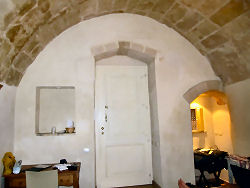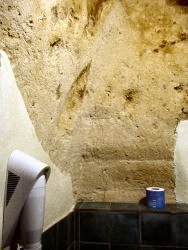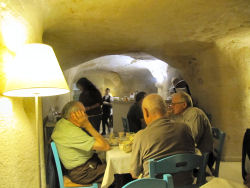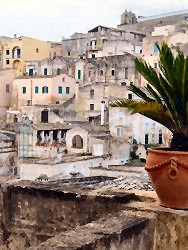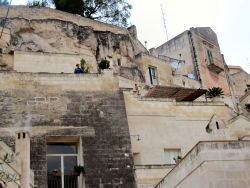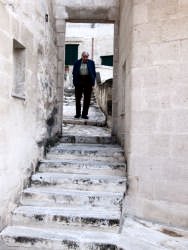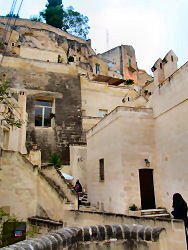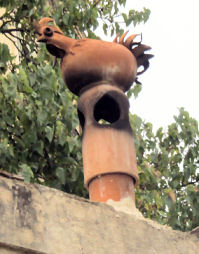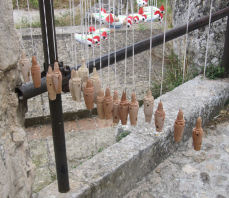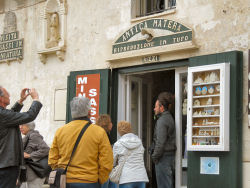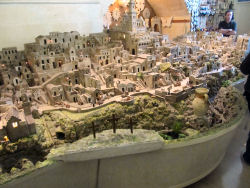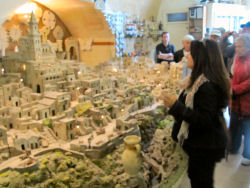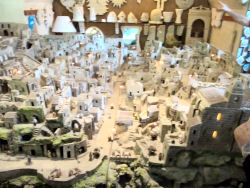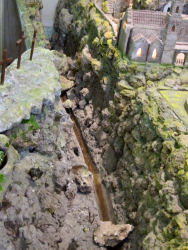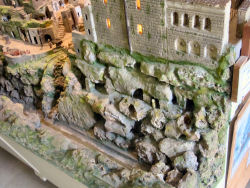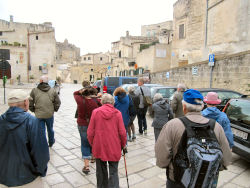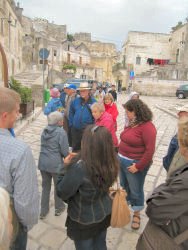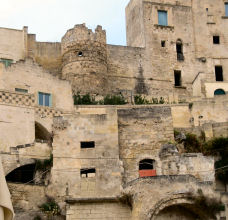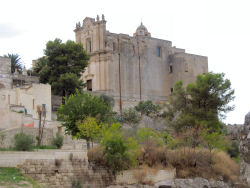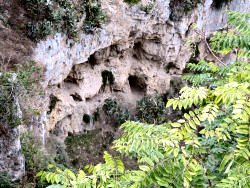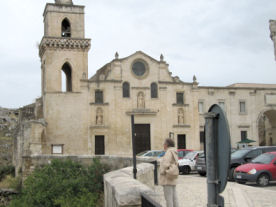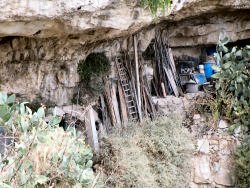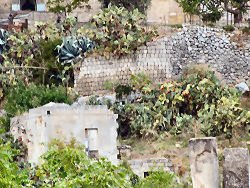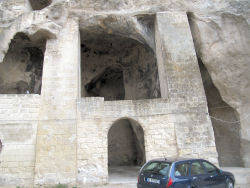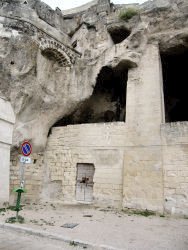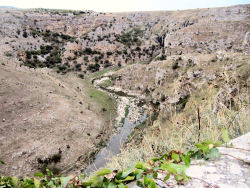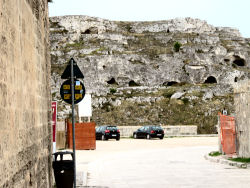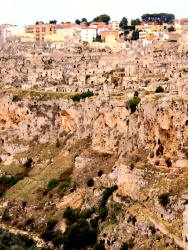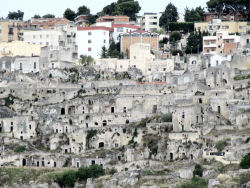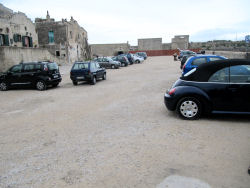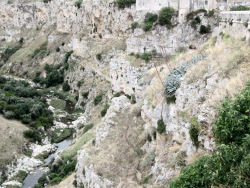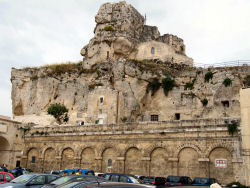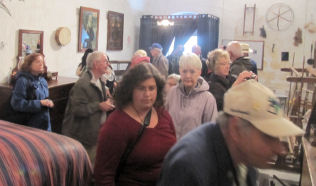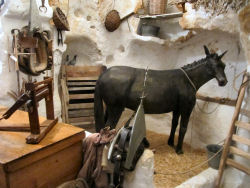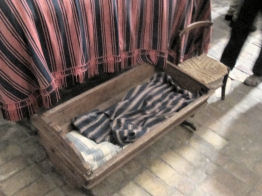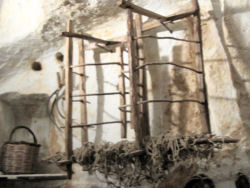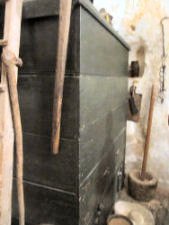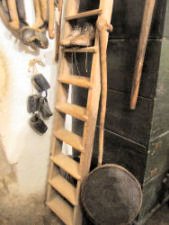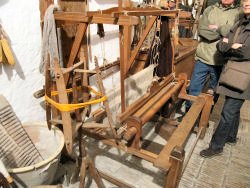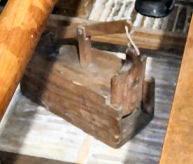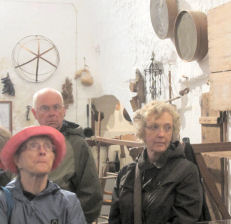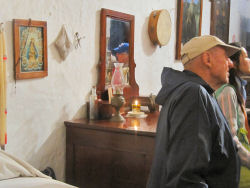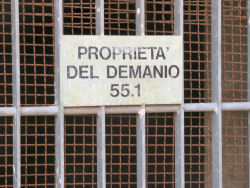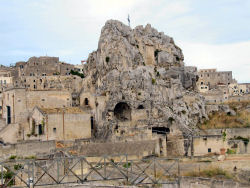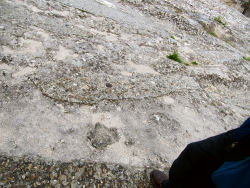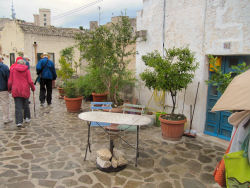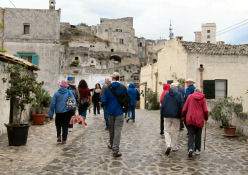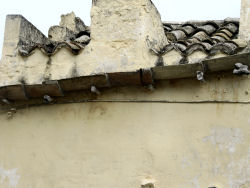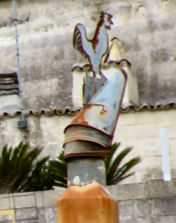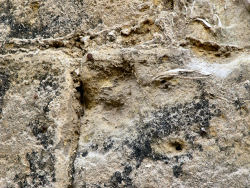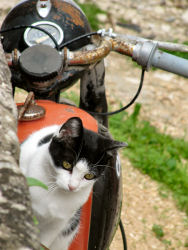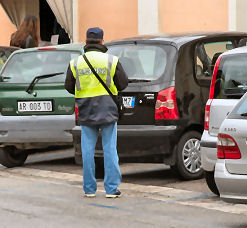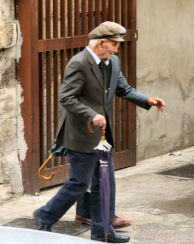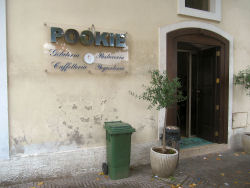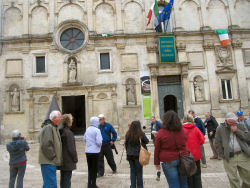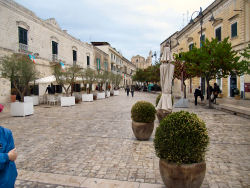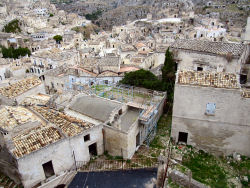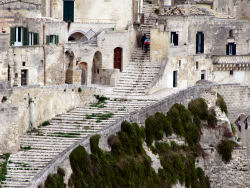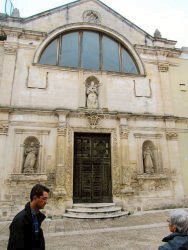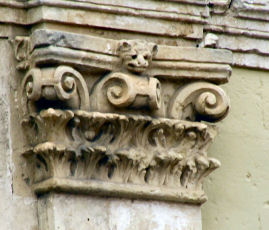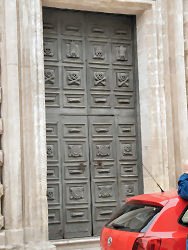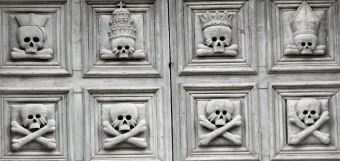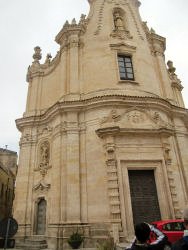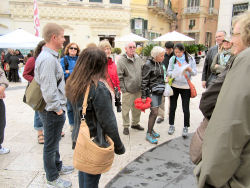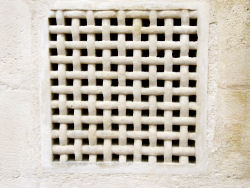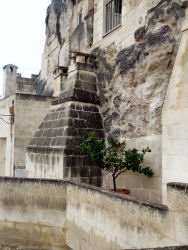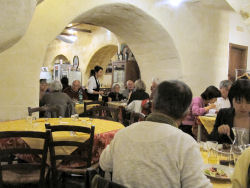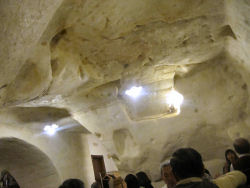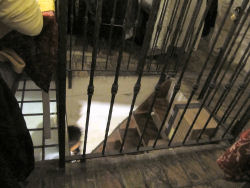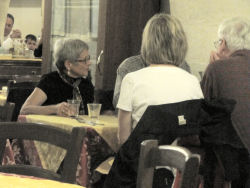I found myself awake a few times during the night. I stumbled out of bed just before seven with a slight headache. Maybe cave-dwelling did not agree with me, or maybe I had a little too much wine the previous night. The mal di testa disappeared in short order.
I spent some time taking photos of the inside of our hotel room in hopes of providing a feel for what it was like to stay in a cave that had been converted into a hotel. The results were, at best, mixed.Sue and I ate breakfast in the hotel’s breakfast room, which was also formerly a cave, with Steve and Edie. Everything else was fine, but the cappuccino was much too frothy. Edie remarked that I showed a lot of dexterity to be able to eat, drink, and take notes at the wine-tasting in Alberobello on the previous day. My brain was in a fog, and I don’t think that I managed to engineer a cogent reply. I have never been good at accepting compliments.
The plan for the day called for the morning to be devoted to a walking tour of Matera with a local guide. The afternoon and evening were free to spend as we wished. Sue decided to forgo the walking tour. This turned out to be a mistake. She should have accompanied us for at least the first half hour or so.The weather was a good deal cooler than what we had become accustomed to. It had rained lightly during the previous night, which meant that the stone sidewalks would probably be a little slippery. Everyone brought raingear because the skies still appeared threatening, but nothing came of it.
We met Emilia, our local guide for Matera, just outside the hotel. She was not much taller than Diann, who was the shortest adult whom I could ever remember meeting. Emilia’s voice did not carry very well, and it took my ear a while to get used to her accent. On the other hand, she really knew her subject matter, and her English was quite good. The Sassi were divided into two districts, the Sasso Caveoso and the Sasso Barisano, in which our hotel resided. They are both on the west side of the canyon, separated by what is now a parking area. Sasso Barisano, which was named after the city of Bari, was in the days before the evacuation mostly inhabited by craftsmen and laborers. These people could afford to build up their dwellings somewhat. Shepherds and peasants formerly lived in Sasso Caveoso. They mostly abided in unimproved cave houses.
The city had supposedly been repairing the cathedral for forty years. It was still closed in 2011. Its campanile was fifty-two meters tall. They had likewise been working on Castel Del Monte[1] for twenty years. It was also still closed.
Emilia showed us a terracotta rooster on a roof. The rooster was one of the symbols of Matera. The Materani think of it as a fertility symbol as well as a sign of good luck.The locals also made – and sold from tables on the street – rooster-shaped wooden whistles called kukus. The name was indicative of the sound that the device produced. I did not buy one.
The capital of Basilicata is Potenza, which is also the largest city. Matera is the second city of the region. Sixty thousand people lived in Matera in 2011, nearly all of them in the new city, which lies above the canyon. Until the new city was built in the fifties, thirty thousand people resided in the Sassi. Carlo Levi, who was born and raised in Turin, spent one year, 1934-5, in the Basilicata region. The Fascist government exiled him there as punishment for expressing his political views too persuasively. De Gaspari read Carlo Levi’s book Christ Stopped at Eboli, visited Matera, and determined to do something about it. Public housing was soon constructed. The citizens were then evacuated from the cave houses, and the Sassi area was eventually renovated to a considerable extent.Molise and Basilicata are still the nation’s poorest regions. They are considered the “shame of Italy.”
At least ten people plus animals lived in each sasso dwelling! Donkeys were used for transport, and they slept in the houses along with chickens and a pig or two. Manure was collected for heat and fertilizer, but it was a constant source of disease. The caves were dark and damp. There was no running water.Basilicata has always been a very dry area. Sometimes several months would pass without precipitation. Channels were created throughout the Sassi in order to direct every drop of rainwater into cisterns. The Materani tried to use eels and pumice rock in the cisterns to purify the water, but disease was rampant. Sewage was hurled right into the canyon. Malaria and other diseases spread because of the lack of hygiene.
In the 1950’s the people in the Sassi were forced to leave. The houses were boarded up, but for a considerable period of time some people still returned to spend the nights in their familiar dwellings.Emilia pointed out the stone churches in the Sassi that have people buried on the roofs. The roofs of many of the buildings were commonly used as streets, pathways, or the foundations of other dwellings. For people living on the side of a canyon this was a necessity.
The poorest cave-dwellers lived in the lowest, most unhealthy levels. Sasso Caveoso was still abandoned in 2011. It contained mostly unimproved cave houses, and no one wanted to live in them.
Our first stop was at a very unusual place, a shop that displayed a miniature representation of the entire Sassi and sold various other handcrafted items. One man, Eustachio Rizzi, created the showpiece from tuff over the course of three years beginning in 1996.
I knew before we even entered that Sue would absolutely love this place. I noted that it was open until 7 o'clock in the evening.
It was definitely a good idea to come here at the beginning of the tour. It was extremely difficult to maintain one’s bearing in the three-dimensional world of the Sassi. Seeing the whole thing in miniature made that at least a little easier.Emilia told us that two million years ago the entire area was under the sea. Fossils of sea creatures can easily be found in the limestone even today. At the end of the tour she showed us some of these.
The Palazzo del Casale and the Augustinian monastery were constructed in the eighteenth century. Mass was scheduled for 7 p.m. on Saturday evening.
The canyon is twelve miles long and about three hundred feet deep. The limestone that lines the canyon is porous. The humidity in the Sassi houses was about 90 percent because of the water evaporating from the cistern and collecting in the floor.Matera is approximately four hundred meters above sea level. Despite the region’s southern latitude, winter does bring snow to Basilicata. This helped the original residents of the Sassi address the problem of food preservation. Ice houses were constructed in the caves with alternating layers of snow and straw.
Emilia answered phone calls on her cell at least three times during the tour. It was a little annoying, but I guess that this is just the way things are done in the twenty-first century.
A car park separated the two districts. Mel Gibson used this parking lot as the set for his shooting of the entrance to Jerusalem in The Passion of the Christ. Emilia told us that the buildings in the new city are tall because the people did not want anyone to be able to see the Sassi. They had grown ashamed of them. In the Sassi balconies were a sign of wealth. None could be found in Sasso Caveoso.In the old days the shepherds crossed the stream at the bottom of the canyon on wooden bridges. There were some small churches on the other side, where the shepherds brought their sheep for grazing.
The more modern church of San Pietro Caveoso dates from the fourteenth century.[2] The rock church, San Giovanni in Monterrone, was built in the ninth century by the Basilian monks.We next visited a small museum called the Casa Grotta of Vico Solitario. The house occupied by this family was evacuated in 1956. The family saved the furniture and donated it to this museum. It therefore represented a reasonably accurate depiction of life in the Sassi in the fifties.The sleeping arrangements were definitely cozy. Four people slept in the double bed. Another person or two slept on the top of one of the chests on a mattress stuffed with corn husks. No one slept on the floor, which was persistently damp. Newborns slept in an open drawer. The donkey slept at the foot of the bed.
The museum was equipped with a sound system that played a recording that described in English life in the Sassi. There were no ovens in the individual homes. One of the women went to the bakery and carried the bread back on her head. There was a cavity in the wall for manure from the animals. There was a chest for clothes, a chest for the wheat, and a larder that doubled as a bed. There was also a dowry chest. Wood was burned for cooking in the small kitchen. Everyone ate from the same large plate. The room had a loom and a mousetrap made entirely of wood.
Visiting the museum made it much easier to visualize what life was like in the Sassi. I would say that the most outstanding attribute was how crowded it must have been. It was difficult to imagine ten people living in one of these small dwellings, and their animals lived there too! They had no electricity, no heat, and no running water. They had each other, however, and they made do with that for ten thousand years.
I took quite a few photos within the Casa Grotta, but I am not particularly proud of them. No photography was permitted in our next stop, the rupestrian churches. I could not even find any photos of the interiors on the Internet.[3]
Emilia next led us to the church in the rock, which was really two different churches. The Latin church, Madonna de Idris, was built in the tenth century. People came here to pray for rain. It originally had a stone floor. Women climbed seventy-five steps on their knees to ask for rain.
Some of the interior decorations were done in tempera, which is not weather resistant. All of those images are ruined.
The altar of limestone was funded in 1804 by a local family. They wanted to be buried behind it. We traversed the passage between the churches to the San Giovanni side. It contained a thirteenth-century fresco of Saint Nicholas. The saint’s body was stolen from Turkey and brought to Bari. He is still entombed in the basilica there.The inscriptions in the San Giovanni church showed a mixture of Latin letters and Greek letters. Approximately one hundred fifty rock churches, many of them Greek, have been discovered.
Not long after the completion of the San Giovanni church, the Basilian monks left the area. No one knows where they went.[5] The Greek rite churches practiced full submersion for baptism. The priests blessed with two fingers, not three. Within the churches some paintings have been found on top of others. In one strange case St. Andrew’s face, painted in the twelfth century, now appears on the Blessed Virgin’s body, which was painted in the thirteenth century. We saw paintings of John the Baptist, identifiable by his long hair and beard, John the Evangelist, who had a feminine appearance, and St. James[6] with a snake and a chalice. The Byzantine wall paintings lacked perspective.A considerable amount of vandalism occurred in the Sassi in the seventies. Quite a few frescoes were stolen or damaged.
Mel Gibson photo-shopped out the modern elements from his movie. He used the big staircase in the Sassi for the scenes of Jesus carrying cross.
Emilia pointed out a gutter that was supported by donkey bones. They petrified and, unlike wood, never rotted. I took a photo.
When we emerged from the Sassi into the new town, it was as if we had entered another world. It seemed extremely modern. We took a bathroom break at a bar named Pookie. Frank bought a gelato, and that seemed to break the ice. Several people ordered something or went shopping. I felt uncomfortable inside the cafe. I went back out on the sidewalk where it was cooler and less crowded. I did some people-watching and snapped a few interesting photos.
We concluded the visit in the part of the town that seemed to contain all of the cultural centers. The museum in the Palazzo Lanfranchi had many paintings by Carlo Levi. We did not enter any of these buildings.
Two towers were visible from that location. The square one was an eighth century Lombard (!) tower. The round one was much less unusual, a Norman construction from the eleventh century.
The Domenico Ridola archeological museum contained many exhibits dating from prehistoric times to the age of the Greek settlement. We did not go in.The baroque church of Santa Clara was decorated with bats on the columns. I do not know what they represented, maybe the caves.
The Memento Mori church was shaped like a mitre. The theme was very clear. Everybody eventually becomes a corpse; concern yourself about your soul. This was brought home strongly by the design on the door where the headgear of priests, popes, kings, and bishops were displayed over skulls and crossbones.
I went down the stairs from Piazza Veneto to the hotel. When I arrived there, I eschewed the elevator and took the stone walk up to the room. I found Sue outside working on her netbook. She explained that she had come out because of ants. I sat with her for a while, but it was a little too chilly for me. I retreated to the room, which, as far as I could tell, was ant-free. I decided to skip lunch. I ate some of my broken cookies and drank water from my Coca Cola Light bottle. I got sleepy shortly thereafter and napped in the cave for an hour or two.
I really missed Tom Corcoran. Sue and I seemed to be having more trouble than usual relating to some of the other travelers. Maybe I was just guilty of making rash judgments, but it seemed like a different sort of group than we had encountered on other Rick Steves’ tours.
I turned on my computer and worked quite a bit on my journal. I had taken several pages of notes that morning, and I got all of them transcribed onto the computerized version.
I signed onto the Internet to get the college football scores only to learn that Michigan would play at Northwestern in the evening. Since we were six hours ahead, the game would barely be over when we woke up on Sunday.Holy mackerel! The Yankees lost to Detroit! Dave Jones would definitely be happy to hear that Texas was playing the Tigers for the AL championship. St. Louis was matched up with Milwaukee in the NL.
I downloaded all of my e-mails, but they were all junk.We decided to eat supper at the restaurant called Nadì that was just down the street. They seated us in the back of the cave with a bunch of Japanese tourists who were staying at our hotel. A little later quite a few people from our our tour group entered and were seated in the arch. For once we arrived too early.
For the appetizer Sue and I split a plate of Antipasto Lucano, which consisted of prosciutto, pancetta, salami, and cheeses. I liked the salami the best. The mozzarella seemed a little runny. For the primo we shared an order of strasciatelli with turnip tops and anchovies. I detected absolutely no taste of anchovy. For the secundo I had grilled chicken. Sue had grilled lamb. She liked her lamb; my chicken was too dry. For some reason we decided not to order wine. The total cost was €45, which was about what it was worth. Our table was positioned right next to the stairs that led down to the wine cellar. In order to preserve space most of the opening was covered with plexiglass.We spent a few minutes admiring the view before we opened the door to the room. Sue then took her computer down to the lobby and checked her e-mail. She discovered that the Corcorans’ plane back to the States had taken off this morning.
[1] This castle, like the one in Vieste, was constructed by the indomitable Emperor Frederick II.
[2] This is rather unusual. The popes were in Avignon from 1309-1379. After that was the western schism.

